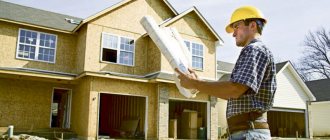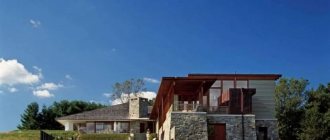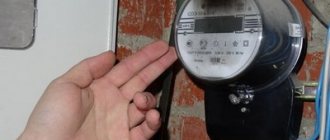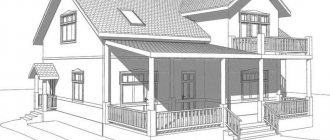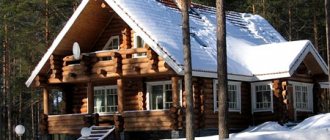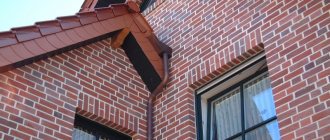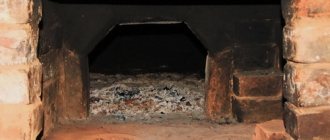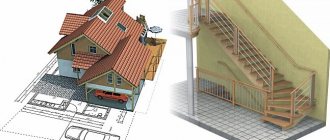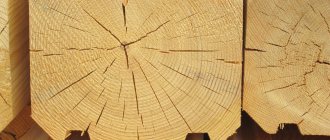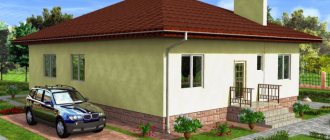Preparation of the land plot
Purchasing a plot of land is a rather complicated procedure for an unprepared person. But only after going through the entire process of registration, receiving a certificate of ownership, cadastral number, permission to use the site for individual housing construction, can you begin to build a house.
You should not start by leveling the surface of the site or cutting down trees for the construction site of the house. A house begins with a project, and a specialist designer always takes into account in his work such subtleties as the terrain or the preservation of trees and shrubs. And, most likely, construction and even preparatory work before the development of a construction project will turn out to be wasted costs.
The terrain of the site has a strong influence on the cost of preparatory work. Source stroytehnika.su
History of the construction of Burj Khalifa
The construction of the Burj Khalifa cost one and a half billion dollars , and the author of the project was the architect Adrian Smith. This architect designed the Jin Mao skyscraper in China, 420 meters high. Interestingly, the contractor for the construction of Burj Khalifa was a division of Samsung. The same division was involved in the construction of the Petronas Towers in Kuala Lumpur, Malaysia.
Beautiful Petronas Towers in Malaysia. This is one of the most elegant buildings. Largely due to the connecting bridge.
Burj Khalifa cost $1.5 billion to build
Interestingly, during the construction of the Burj Khalifa, the final height of the tower was kept secret. In general, there are many secrets in the world, but in this case it was done so that if someone decides to build a building higher, the project could be changed and still be higher.
The foundation of the building was laid in 2004, and construction itself proceeded at a rate of 1-2 floors per week. 12,000 workers from different countries were engaged in construction every day . In total, the construction required more than 300,000 cubic meters of concrete and 60,000 tons of steel reinforcement.
Starting in 2007, the tower began to surpass previous height record holders until it became the tallest. It finally reached its height of 818 meters in early 2009, a little less than a year before the official opening.
Sketch standards
Building codes recommend starting design with a sketch. The primary task is to determine the boundaries of the “development area” of the site, taking into account a number of rules and regulations:
- the distance from the road (roadway) to the designed house must be at least 5 m;
- the front façade of the house must face the street;
- the distance from the fence of the site to the house is at least 3 m;
- the distance from commercial non-residential buildings to the house is at least 1 m;
- between residential buildings the minimum distance is 6 m;
- the project must take into account orientation to the cardinal points;
- the project must take into account the possibility of erecting other buildings on the site;
- the project must take into account the possibility of connecting the house and other buildings to utility networks.
The average area of individual houses being built on two floors or one floor with an attic ranges from 100 to 300 m². Standard overall dimensions in length and width vary from 8 to 16 m. These are the sizes and areas in the most popular range with a full range of auxiliary premises for comfortable living. Let’s take an average area of 200 m² to understand in more detail: how much it costs to build a turnkey house in 2021.
A construction sketch of the house and the adjacent area helps not only to correctly carry out the layout, but also to determine priorities in work Source mebel-go.ru
Guest room
Everything you need for a comfortable stay can be placed on 15 square meters. m. A soft sofa, a spacious cabinet and a wardrobe - this is enough for a cozy time. When the room is empty, you can do your favorite creative work in it.
It is recommended to choose a neutral palette; bright, rich colors are a matter of taste, and not everyone will be able to feel calm in a colorful room.
Next to the guest room there is 5 sq. m for a toilet with a bath. A washing machine can also be installed here. White, pale blue or beige colors are used for decoration.
Components of the preliminary design
Development of a preliminary design using the method of selecting the best solutions based on the wishes of the customer and the knowledge of a professional architect allows you to create the most successful and rational version of the exterior of the house and avoid unpleasant surprises during construction.
The sketch itself can be divided into two parts:
- Planning development scheme (PZU). It indicates all proposed additional buildings, small architectural forms, vegetation, and fences.
- t600142-3D model of the site development, which allows you to visually evaluate the solutions included in the sketch.
Project development stages
Project development includes several stages, each of which is important in itself, but inseparable from the others - that is, cannot be calculated without taking them into account.
Architectural solutions
For the first floor, the usual set of premises: vestibule, hallway, corridor, bathroom, kitchen, if there is a second floor or attic - a staircase, if there is no separate room - a boiler room and a boiler room. It is possible to plan a guest room, an office, as well as rooms for laundry, wardrobe placement, storage of clothes or food, and a number of other special-purpose rooms. It is possible to provide a veranda or terrace.
Architectural design of the house Source talkshows.ru
On the second floor there can be bedrooms, a bathroom, and an office. Sometimes balconies, dressing rooms and other premises necessary for the owner are arranged.
The next stage of this stage is to determine the height of the floors “in purity”. This is the height from the finished floor to the ceiling, usually ranging from 270 cm to 330 cm. After which the material for finishing the facade is determined.
Construction
After the sketches and architectural solutions are fully prepared, construction follows. At this stage, the structures of foundations, walls, roofs, and roofs are worked out in detail:
- the development of layout diagrams of individual elements and junction units is being carried out;
- specifications of individual elements are drawn up;
- Solutions and recommendations for installation are offered.
Engineering-geological surveys can be considered as an obligatory component of the design. Essentially, this is a report on the characteristics of the soil at the construction site. It is necessary to calculate the foundation of the house - the foundation.
Typically, for an individual house, it is enough to drill two or three wells 6 m deep to obtain the necessary data on soil conditions.
See also: Catalog of brick house projects presented at the Low-Rise Country exhibition.
Network engineering
The design of utility networks (electrical, heating, water supply, sewerage, ventilation) mainly depends on external initial parameters and is carried out after the development of design solutions is completed.
Engineering communications are an obligatory part of the project Source brusbani.ru
A building permit is issued by the Department of Architecture of the construction area; to obtain it you need:
- site layout diagram;
- architectural and construction solutions;
- Constructive decisions;
- solutions for engineering networks.
How much does it cost to build a house: price calculator 2017-18-19…
Approximate calculations of design costs are based on the total area of the house from 40 m² and not higher than three floors:
- The cost of geological surveys depends on the location of construction and the depth of drilling wells for analysis. The cost of surveys should be calculated based on the approximate cost of drilling one linear meter of soil in 2000 - 2400 rubles.
- The estimated cost of a preliminary design of a house with a plot layout of up to 20 acres is 110 rubles per 1 m² of house area.
- Architectural and construction solutions and structures (ASRC) will cost the customer from 170 to 220 rubles per 1 m² of house area, depending on the complexity of the roof structure
- Projects of engineering solutions, approximate cost for the total area of the house: water supply and sewerage – 50 rubles/m²; electrical equipment – 50 rubles/m²; heating, air conditioning, ventilation – 50 rubles/m².
- The average cost of a design project ranges from 200 to 500 rubles/m², depending on the complexity.
A design project must take into account many nuances and wishes of the home owner Source yandex.ru
- Warm floor project: from 40 rubles per m² of heated premises
The total cost of an individual project for a house with an area of 200 m² will be:
- minimum – 158 thousand rubles:
- maximum – 233 thousand rubles.
You may have to add about 10% to the total for unforeseen expenses. The answer to the question of how much it costs to build a turnkey house will be given by a full calculation of the parameters included in the project.
See also: Catalog of companies that specialize in the design and construction of turnkey brick country houses.
Tallest building on Earth
Currently, the tallest building in the world is the Burj Khalifa. At the same time, the Burj Khalifa is a residential/office building and broadcasting radio or television signals is not its main task. Translated from Arabic, the name Burj Khalifa means “Tower of the Khalifa.” Until 2010, this huge building was called Burj Dubai (Dubai Tower). But when opening the tower, the ruler of the Emirate of Dubai renamed it, dedicating the building to the President of the UAE, Sheikh Khalifa bin Zayed Al Nahyan.
This is not just a skyscraper, but an ultra-tall skyscraper with a height of 828 meters, which is as many as 163 floors . In shape it resembles a stalagmite, which we have already talked about. This shape gives it more stability.
Stalagmites are mineral formations that grow in the form of pillars (cones) at the bottom of caves and other underground cavities. Stalactites grow towards them. Often they grow together, forming stalagnates.
The grand opening of the tower took place on January 4, 2010 , although it was originally planned for three months earlier. The earlier launch date was planned to coincide with the launch of the Dubai Metro. Surprisingly, such a delay was caused by problems with financing. Somehow it doesn’t fit with the way they spend money in Dubai.
This is what the tower looked like when it was just starting to be built.
Even two and a half years before completion, the tower became the tallest thing that man had made. It was ahead of the Warsaw radio mast, which fell in 1991.
The Warsaw radio tower had a height of 646.38 meters. The tower collapsed on August 8, 1991 while one of the guy wires was being replaced.
The Burj Khalifa is more than just a tower. It is practically a city within a city. Inside there are residential premises, offices, shops, sports centers, entertainment complexes and much more. Outside there is a park with lawns and fountains. Everything together looks very futuristic.
A little more about construction. They want to build a space hotel on the ISS.
Foundations: cost of construction and installation work
How much it costs to build a house from scratch also depends on the foundation used. To build a brick house, any type of foundation can be used. The feasibility of constructing a particular type of foundation is determined by the calculated design loads, the depth of groundwater and the type of soil.
Pile foundations
Piles can be used: bored, bored with casing, driven, pressed, screw:
- Bored piles : the cost depends on the reinforcement scheme, depth, diameter, required upper elevation, total volume of work and ranges from 1900 to 3800 rubles/m³
- Drilling with casing : the cost of work starts from 4,500 rubles/m³
- The cost of driving depends on the size of the pile in cross-section and length, the cost of work starts from 500 rubles per m.p.
- The cost of pressing piles depends on the cross-section, length of the pile and the soil of the site: from 1000 rubles per m.p.
- The cost of screwing piles depends on the diameter, length of the pile and ground conditions from 350 rubles per m².
Piles can be driven using special equipment or manually Source po-almash.ru
Poured concrete foundations
- Monolithic strip reinforced foundation - grillage. The cost of a monolithic reinforced concrete foundation includes reinforcement and formwork work: from 2100 to 4200 rubles/m³
- The price of installing FBS blocks or FL slabs of a prefabricated strip foundation depends on the size of the slabs or blocks and varies from 850 to 1300 rubles per piece.
- The cost of installing a slab monolithic foundation varies with changes in the reinforcement scheme, depending on the height difference and the shape of the slabs: from 2000 to 4000 rubles/m³
- Prices for installing a columnar monolithic foundation vary from the type of reinforcement, the number of steps, the depth of the base, the number of embedded parts: from 2800 to 5500 rubles/m³.
If we calculate the construction of a foundation for a house with an area of 200 m² of square section, then, taking into account the freezing depth for the middle zone, the installation of a strip monolithic reinforced foundation will cost:
- Minimum: 175 thousand rubles excluding the cost of materials.
- Maximum: 350 thousand rubles. also without material costs.
Pouring a strip foundation Source rstk.net
The increase in the cost of foundation work may be affected by the distance to the construction site, poor condition of roads to the site, proximity to groundwater, difficult soil development and an increase in excavation work, the need for increased reinforcement, and weather conditions.
Tallest buildings in Russia
In Russia there are also several buildings that are included in the ranking of the tallest in the world. The tallest building in our country is the Ostankino TV tower with a height of 540 meters. The TV tower was built in 1967 and is still the tallest building in Russia and Europe. The Ostankino TV Tower ranks 16th in the ranking of the tallest buildings in the world.
The tallest building in Russia that is not related to the broadcast of radio or television signals is the Lakhta Center in St. Petersburg with a height of 462 meters. This is 26th in the world ranking of the tallest buildings in the world.
Also among the tallest buildings in the world there are several more television towers and office buildings, including the buildings of the Moscow City complex. Here's what the list looks like based on world rankings:
- Ostankino TV Tower , Moscow, 540 meters, 16th place in the world
- Lakhta Center , St. Petersburg, 462 meters, 26th place in the world
- Boganida radio tower , Boganida, 461.5 meters, 27th place in the world
- Inta radio mast , Verkhnyaya Inta, 461 meters, 28th place in the world
- Balashikha radio mast , Balashikha, 427 meters, 43rd place in the world
- Radio mast of station RJH63 of the RSDN-20 system , Imeritinskaya, 425 meters, 46th place in the world
The Ostankino TV tower is the tallest of all buildings in Russia and Europe.
Above are the tallest buildings in Russia , included in the world ranking of buildings, masts and television towers. There is also a separate rating of office/residential buildings . It includes the Lakhta Center (St. Petersburg, 462 meters, 16th place in the world), the Federation East Tower (Moscow, 373 meters, 54th place in the world) and the South Oko Tower (Moscow, 353 meters, 69th place in the world).
Lakhta Center. Tallest building in Russia and Europe
Lakhta Center in St. Petersburg is ranked 16th in the ranking of the tallest office residential buildings in the world. Its height is 472 meters. This is the tallest building in Russia and Europe. And also the northernmost super-tall skyscraper.
Masonry of walls and partitions
The construction of walls entirely made of brick is extremely rare today. In any case, such walls are made of two layers, two types of bricks: rubble for the internal rows and facing from the facade. More often, rubble brick is replaced by large-block piece materials: cinder blocks, expanded clay blocks, foam blocks, gas blocks, wood concrete and others. Such combinations allow you to speed up construction, achieve savings, build a warmer house and simplify interior wall decoration.
You can roughly imagine how much it costs to build a house made of brick by calculating the consumption of bricks and other wall materials. This, in principle, is not difficult: just multiply the perimeter of the building by the height of the walls, then subtract the area of all openings from the result and multiply the result by the thickness.
Specialists use specialized software for calculations, but the approximate consumption can be “estimated” using a regular online calculator Source sambud.in.ua
For example, to build a brick house with a plan size of 14 x 14 m on one floor, an approximate calculation of its quantity will look like this:
- building perimeter: 56 linear meters;
- area of three doors and 10 windows: 30 m²;
- brick wall thickness: 0.38 m;
- wall height 3.5 m;
- (56 x 3.5 -30) x 0.38 = 63.08 m³ of brick;
- in one cube 380 pcs. single brick, which means the total quantity required for construction is 63.08 X 380 = 23971 pcs. or approximately 24 thousand pieces.
Cost of laying bricks and some types of blocks
The masonry should be divided into front facing bricks with excellent geometry and a smooth or decorative surface of the edges, as well as backfilling made of inexpensive and simple bricks. In some options, blocks are laid as backfill, so you should also look at the prices for their installation.
Brick in masonry, cost of work:
- backfill masonry of a single ordinary brick: from 1500 to 3200 rubles. for 1 m³ of masonry;
- backfill masonry, ordinary one-and-a-half brick: 1400-3100 rub/m³;
- backfill masonry, ordinary double: 1300-3000 RUR\m³;
Backing brick laying Source torange.biz
- backfill masonry, cinder block, foam block, gas block, ceramic block, polystyrene block: from 1100 to 2900 rubles/m³;
- backfill masonry made of rubble stone: 1300-4500 RUR\m³;
- facing masonry, single facing brick: 1300-2700 RUR\m³;
- facing masonry, one-and-a-half facing: 1300-2700 rub/m³;
- partition masonry, single or one and a half row brick: 450-750 rubles per m².
Some types of bricks with prices and brief characteristics
The choice of bricks on the market is impressive, so general information about some of its types will not be superfluous as a general overview:
- dark red brick for cladding facades with possible use in the construction of stoves and fireplaces, GOST 530-2007, standard sizes, single, cost up to 11 rubles per piece;
- ceramic brick, one-and-a-half, red, for exterior use, expressive texture, produced in accordance with GOST 530-2007, approximate price 13 rubles per piece;
One and a half ceramic hollow brick Source kirpichman.ru
Used foreign cars up to 200,000 rubles: top 5 worthy offers
We will talk exclusively about foreign cars for the reason that the Russian auto industry, alas, even in its new form sometimes represents a source of technical problems. And even more so in a used one. Another problem is the quality of domestic components, which are often enough for a minimum period of time, after which they have to be changed again. In addition, we boldly add to foreign cars the fact that they have ergonomics, comfort, customized driving habits and other delights of foreign car brands, which our cars are most often deprived of.
In general, for any money, look for a foreign car, because when Europeans make a car for Europeans, this is very different from the approach when AvtoVAZ makes a car for Russians.
So, we define the search conditions. First of all, we set the price criterion a little higher - at the level of 210-220 thousand rubles, since bargaining for 10-20 thousand in the event of a purchase decision is not a problem.
Secondly, we cut off all cars older than 10 years - this is the age that still provides some guarantees for the technical and moral condition of the car. In the end, most foreign car brands provide a 10-year guarantee against through corrosion, which means that at least with the body, if the car has not been in an accident, problems can be avoided. By the way, at this age there are still examples from the same hands (!), which dramatically increases the chances of getting a well-maintained car.
And thirdly, we move “show-off” into the background. You can’t get any “Japanese”, “German”, or solid middle-class cars, not to mention crossovers, for that kind of money. Even the automatic transmission will have to be forgotten. All participants in the selection are high-quality “state employees”, whose main competitors in our market have always been “Zhiguli”.
Peugeot 206\206 Sedan
Photo: Peugeot press service.
One of the most successful Peugeot models ever. The car turned out to be so inexpensive, durable and unpretentious that in France itself it outlasted both the Peugeot 207 and even the 208 on the assembly line.
2009 was the last year for the car, after which the 206+ version appeared in Europe, and the 206 Sedan in Russia. Let us immediately note that the hatchback and sedan differ not only in the body. Hatchbacks are only French, but the sedan is the fruit of licensed production of the Iranian company Iran Khodro. Alas, the quality of the Middle Eastern assembly and the materials used did not differ for the better from the original products.
One way or another, the car in the vast majority of variants will be equipped with 1.4 (75 hp) gasoline engines or in top versions 1.6 (109 hp). Both engines with a timing belt drive and with proper care are very durable, especially the 1.4. Over time, it is worth paying attention to all kinds of sensors, the ignition and cooling systems, as well as replacing gaskets that may leak.
The Peugeot 206 has two problems - the rear beam, the bearings of which can withstand about 80,000 km, and the notorious AL4 automatic. Nobody repairs the beam - it is simply replaced with a restored one and the faulty one is returned. But it’s better to simply avoid the machine, although you learned how to repair it a long time ago, although it doesn’t help for long. Everything else is little things that are inexpensive and easy to change due to the simplicity of the design.
Fiat Albea
Photo: Fiat press service.
The Italian sedan is built according to the scheme of a typical “state employee”: converted from the European Palio hatchback with assembly in Latin America, Eastern Europe, Turkey and even Russia. Despite its not the most sophisticated forms, Albea was a good success due to its excellent combination of price and consumer characteristics.
The key to the car's endurance is that in Russia it was sold in a single version - with a good 1.4 petrol engine (77 hp) and only a manual gearbox.
The main disadvantage of the Fiat Albea is the widespread use of inexpensive components that do not last very long in our conditions. Sensors, filters, belts, suspension parts, bearings, clutch - all of this has shortened replacement intervals, which sometimes do not exceed 50,000 km. All kinds of anthers most likely will not survive the frosty Russian winters. In addition, Fiat turned out to be demanding on the quality of oil and especially fuel.
In general, we can say that a Fiat Albea, with good care, does not cause any special problems until at least 150,000 km. And the fact that older people usually became the owners of the car indicates a large number of copies in decent condition.
Chevrolet Aveo I restyling
Photo: Chevrolet press service
Subjectively, it is the most modern in terms of external and internal aesthetics, and in a sedan body it is also the most solid car in our rating. This fact meant that the car had a mixed clientele, including a young one who did not particularly care about condition. So today on the secondary market there are both very well-kept specimens and barely alive ones. You need to look at the previous owner.
The car was sold in Russia with two engines - 1.2 and 1.4 liters. A significant feature is that both engines underwent modernization right at the turn of 2008-2009, so it is better to choose the most recent copy, which is guaranteed to be updated. Moreover, Aveo is the case when the younger engine turned out to be more reliable than the older one. After the update, the 1.2 engine received a chain instead of a timing belt, as well as a 16-valve system.
The 1.4 engine became famous for breaking camshaft gears, which resulted in the owner having to undergo serious repairs. Since 2009, the problem has been eliminated. One way or another, both engines are demanding in terms of maintenance and fuel quality - oil change intervals are no later than 10,000 km, gasoline is strictly 95.
You can’t get an automatic for the specified price for the Aveo, and therefore all versions will be equipped with a manual transmission. It has average reliability - you need to monitor the oil level, there may be problems engaging the first two gears. The suspension is distinguished by the use of not the most expensive components, and therefore has average characteristics of both tuning and reliability. In addition, it regularly contains extraneous sounds.
The main criterion for choosing a Chevrolet Aveo is a proven history and the most recent copy after 2009. Serious problems with Aveo are unlikely to happen, but little things can bother you.
Renault Logan\Renault Symbol
Logan is, one might say, a legend of the Russian market and one of the most common cars on the secondary market. However, we will consider it in tandem with its brother Clio Symbol, which also deserves attention.
We wrote about all the technical features of Renault Logan in a separate detailed article. Taken as a whole, this is one of the most indestructible cars on the Russian market. For this reason, carefully study the offers, since there is a high chance of running into a taxi with terrible mileage and condition with good external characteristics.
Traditionally, Logan is embarrassed by its dingy interior and poor ergonomics, in which, for all its spaciousness, for example, it is impossible to fold the rear seats.
If you want European comfort with relative simplicity, look towards the Clio Symbol. The car has a specific appearance and a cramped interior, but in it you can get a full range of European benefits - comfort, ergonomic interior, tuned suspension and equipment rich for the class.
At the same time, the car is not much inferior to Logan in reliability, with the exception of perhaps a more delicate suspension and a tendency to corrosion. The car is equipped with two 1.4 engines - 75 or 98 horsepower. The main requirement is to change consumables and oil more often. The timing drive will require replacement after 50-60 thousand km; it is best to change the spark plugs immediately along with the coils; radiators suffer from flying stones. Air conditioner pipes rot.
The more powerful 16-valve engine has the peculiarity of trimming at idle - it does not affect reliability, but you can try increasing the idle speed.
The most important advantage of both Renault sedans is the availability of spare parts and reasonable service prices. Even at a dealer, a complete maintenance with diagnostics, oil change, all filters and even front brake pads today costs about 6-7 thousand rubles, taking into account discounts for out-of-warranty cars. It is not surprising that ten-year-old Logan and Symbol are regularly found with a full service history and even a “living” service book - the merit of caring owners, most of whom are elderly.
Opel Corsa D
Photo: wikimedia.org.
Not counting the old Peugeot 206, this is the only representative of a full-fledged European automobile industry, and a German one, without any discounts on the budget, fitting into 200,000 rubles. The car, for example, has the highest quality interior made of good materials, which even after ten years looks good.
The only thing is that you won’t be able to find cars younger than 2008. Also, expect only the most basic trims, including no air conditioning and even no power windows.
For the specified money, there are Corsas on the market with the simplest 1.0 (60 hp) engine or, in rare cases, 1.2 (80 hp). The latter option may even be equipped with an EasyTronic robotic gearbox, which is best avoided immediately.
Interestingly, both engines have a timing chain and are generally quite reliable. Due to its weakness, the base engine always works at the limit of its capabilities, and therefore it needs increased attention. The questions are mainly about seals and gaskets that are not very tight. Problems may largely relate to attachments - all kinds of sensors, the notorious EGR valve, starter, thermostat and ignition modules.
It is up to the mechanic to choose between the two gearboxes. The primitive robot is a source of non-stop problems both in use and in repair. As for the suspension, the Opel Corsa is of average reliability: shock absorbers, springs and wheel bearings last about 60,000 km. Weaknesses include the electric power steering rack.
Conclusion
The main result can be described by the famous proverb “he who seeks will always find.” Even for little money, the market today is full of decent deals on cars that people may be selling for a variety of reasons.
Don’t rush to the first ad you come across, study the seller and immediately determine that even the very good condition of the car does not abolish the laws of physics. After buying a car with a mileage of 100,000 km, due to wear and tear, at least all consumables and some suspension elements will have to be changed, so have another 30,000 thousand in reserve for mandatory preventative repairs.
Cost of roofing work
Prices for roofing work do not include the treatment of wooden products with protective paints and antiseptics and the cost of the material itself:
- installation of pitched roof mauerlats: 450-800 rubles per linear meter;
- installation of a rafter system for a pitched roof with a ridge, posts, and pediment elements: 300-700 rubles per linear meter;
- installation of fillies: 150-450 rubles per piece;
- installation of ceiling sheathing, counter-lattice, pitched roof: 75-200 RUR/m²;
- corrugated sheets, corrugated sheets, metal tiles: 150-300 rubles per m²;
- Euro slate: 150-250 rubles/m²;
- soft tiles: 350-550 RUR\m²;
- roll roofing: 200-500 rub/m²;
- slate tiles: 600-900 RUR\m²;
- ceramic, composite, cement-sand tiles: 350-550 rubles per m².
Moisture protection
A big house has a big roof. The attic space can be used as an attic, but it won't be of much use if it leaks.
There are various roofing materials. They differ from each other in several parameters, such as: weight, reliability and noise.
If you put corrugated sheets on the roof, the whole house will not be able to sleep due to the loud noise during rains. To avoid this, you can apply sound insulation.
House 140 sq. m.: finished projects, tips on choosing the design and decoration of a home (125 photos)House 9 by 11: ready-made projects and optimal solutions for placing rooms. 130 photos of interior and exterior design ideas
- Blue curtains: review of popular shades, combination options, new designs
Finishing work
Finishing work should be considered the most unpredictable in terms of prices for its implementation. The variety of finishing materials in different price groups, again using a variety of consumable fastening, adhesive, coloring and other additional materials, requires a long and careful study.
To roughly estimate the costs of finishing work, experienced builders proceed from an unspoken rule: the cost of the work should be slightly lower than the cost of the material. In general, interior decoration according to an individual design project can amount to from 30 to 50% of the estimated cost of the house.
If we focus on market offers for the construction of houses with an area of 200 m² according to standard projects, then the construction of such a house will cost the customer:
- using block wall materials or rubble bricks: 4900 thousand rubles;
- with façade finishing made of facing brick: 6,500 thousand rubles;
- interior decoration according to an individual design project can amount to 3,200 thousand rubles.
The total cost of building a brick house is 200 sq. m turnkey will be approximately 10-20 thousand rubles. per m²
Tallest buildings in the world
Among the tallest buildings in the world, there is not yet a single one that has reached even the height of the Burj Khalifa. In second place in height is the Shanghai Tower with a result of “only” 632 meters, which is almost 200 meters lower than the Dubai Tower.
This is Shanghai Tower. The second tallest skyscraper in the world.
When calculating the height of buildings, it is customary to take the height of the ground at the main entrance to the building as the zero mark, and the actual top point of the structure as the top mark. The difference between these two points is the height of the building. Antennas, removable spiers, flagpoles and other non-permanent structures do not count.
The top ten high-rise buildings in the world look like this:
- Burj Khalifa , Dubai (UAE), 828 meters
- Tokyo Skytree Tower , Tokyo (Japan), 634 meters
- Shanghai Tower , Shanghai (China), 632 meters
- KVLY-TV TV and radio tower , Traill County (USA), 630 meters
- KRDK-TV broadcast tower , Traill County (USA), 628 meters
- KXTV/KOVR TV and radio tower , Walnut Grove (USA), 625 meters
- Guangzhou TV Tower , Guangzhou (China), 604 meters
- Royal Clock Tower , Mecca (Saudi Arabia), 601 meters
- Ping An International Financial Center , Shenzhen, 599 meters.
- Goldin Finance 117 , Tianjin, 597 meters
As you can see, the difference between second and tenth place does not reach even 50 meters, and Burj Khalifa is ahead of them by as much as 200 meters. This is impressive. For comparison, Borje Milad in Tehran with a height of 435 meters is 200 meters behind second place. This is 41st place in the ranking...
